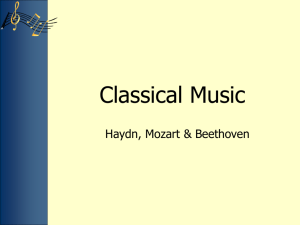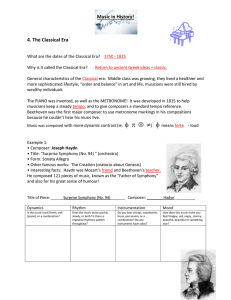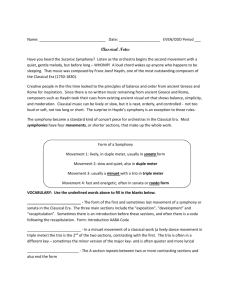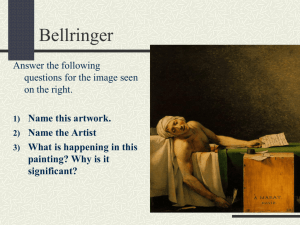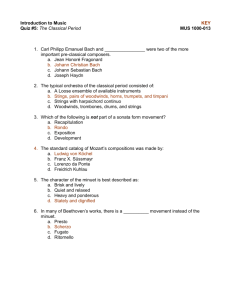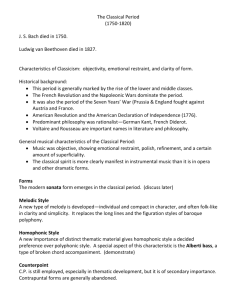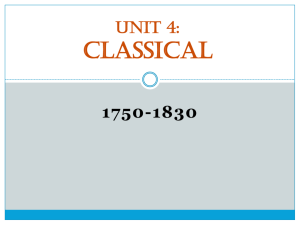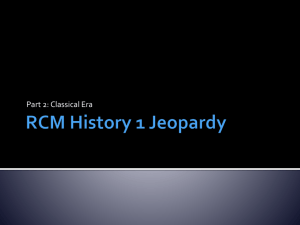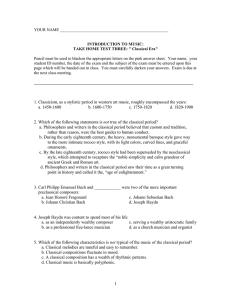The Classical Era POWERPOINT
advertisement
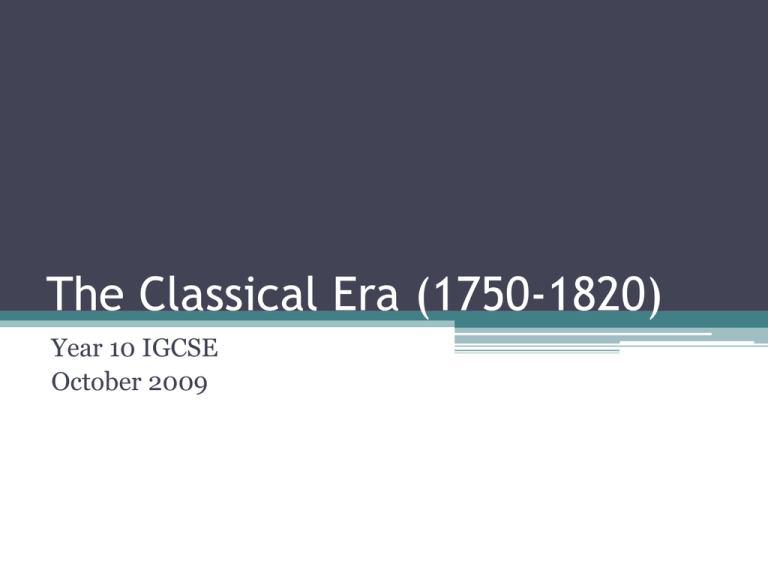
The Classical Era (1750-1820) Year 10 IGCSE October 2009 The Age of Enlightenment • Believed in progress, rising middle class • American and French revolutions • Humanitarian Ideals/reason and knowledge • Liberty, Equality and fraternity! Musical Style • Polyphonic texture to simple melodies • Light and graceful music (style gallant) • Epitome of classical music 1770-1820 • Music printing and increase amateur performances • Opera and concerto grosso becomes symphony • Suite became sonata Elements of Music Characteristics • Changes of mood ▫ Can be sudden (unlike Baroque) but unified • Rhythm ▫ Flexible (sudden or gradual) • Texture ▫ Homophonic – but can change, more vertical schemes • Melody ▫ Tuneful and sometimes borrowed ▫ Balanced and symmetrical • Dynamics ▫ Range and not just terraced dynamics, crescendos used ▫ piano instead of harpsichord (1775) – forte piano • Basso Continuo ▫ Obsolete – more amateur friendly – rid improvising Standard Orchestra • Strings, Woodwinds, Brass, Percussion • Larger number of musicians (25-60) • Specific timbres considered • Continuo disappeared • Conductor with baton and clarinet! • More balanced between strings and winds • Orchestra more like that of today Form • 4 movements usually ▫ ▫ ▫ ▫ 1. Fast 2. Slow 3. Dance-related movement 4. Fast • Symphony = 4 movements, orchestra • string quartets = 4 movements, 2 violins, viola, cello • Sonata = one or two instruments (most formal, developed by Haydn and Mozart) • CONTRASTING THEMES in one movement • BALANCE OF SECTIONS (tension resolved) Life in Classical Period • Composers affected – breaking free from control ▫ Haydn ▫ Mozart ▫ Beethoven • More public concerts – spread through Europe • Middle class people started playing instruments • More demand for printed music • More comic, vulgar Sonata Allegro Form • Single movement form – usually the form of the 1st movement of symphony, quartet or sonata • 3 sections:ABA ▫ Exposition: ▫ Development ▫ Recapitulation ▫ CODA • Listen to Mozart Symphony No. 40 in G Minor 4th Movement Mozart Symphony No. 40 in G Minor 4th Movement Notes: Theme and Variations • Independent piece or as a movement of a symphony, sonata, or string quartet • BASIC IDEA repeated and changed • This idea can be borrowed or composed BASIC STRUCTURE: Listen to: Haydn’s Symphony No. 94 in G Major 2nd Movement Notes from Listening Minuet and Trio • Usually as the 3rd movement of symphonies and quartets • Triple meter and moderate • A(m)B(t)A(m) - trio quieter usually • STRUCTURE: • Listen to Mozart’s Eine kleine Nactmusik 3rd Movement Haydn’s Symphony No. 94 in G Major 2nd Movement Notes: Rondo • Independent or as a movement • Lively, regular and conclusive • Tuneful main theme (usually simple) that returns in alternation • STRUCTURE: • Sonata-Rondo STRUCTURE: Classical Symphony • Origin from 17th century opera overtures • Extended – 20-45 minutes • Haydn wrote many of the early symphonies • Usually 4 movements with range of contrasts ▫ ▫ ▫ ▫ 1. fast dramatic (usually sonata form) 2. slow lyrical (sonata form, ABA, or T+V), diff key 3. dancelike 4. fast heroic (sonata or sonata-rondo) Classical Concerto • 3 movement work for instrumental soloist and orchestra ▫ ▫ ▫ ▫ Fast (cadenza) (sonata form with 2 expositions) Slow Fast (cadenza improvisation) (rondo or sonata-rondo) then CODA (short) • Interplay of melody lines and cadenzas • Mozart and Beethoven wrote many (star in each on piano) • 20-45 minutes Classical Chamber Music • Imitate room setting • 2-9 musicians – entertain guests • No conductor • STRING QUARTET – a fine art ▫ Usually 2 violin, viola and cello • Usually 4 movements ▫ ▫ ▫ ▫ Fast Slow Minuet Fast • OR sonata (violin/piano), trio (piano, violin, cello), quintet Sacred Choral Music • Oratorios and masses were most elaborate in 18th century ▫ MASS – Haydn wrote most exuberant masses Classical sacred music mixes classical MELODYHARMONY and POLYPHONIC IMITATION ▫ Oratorios – musical setting of sacred text • Comic Opera Opera Buffa – Comic Opera (ie La Serva Padrona by Pergolesi, Mozart`s Don Giovanni)


